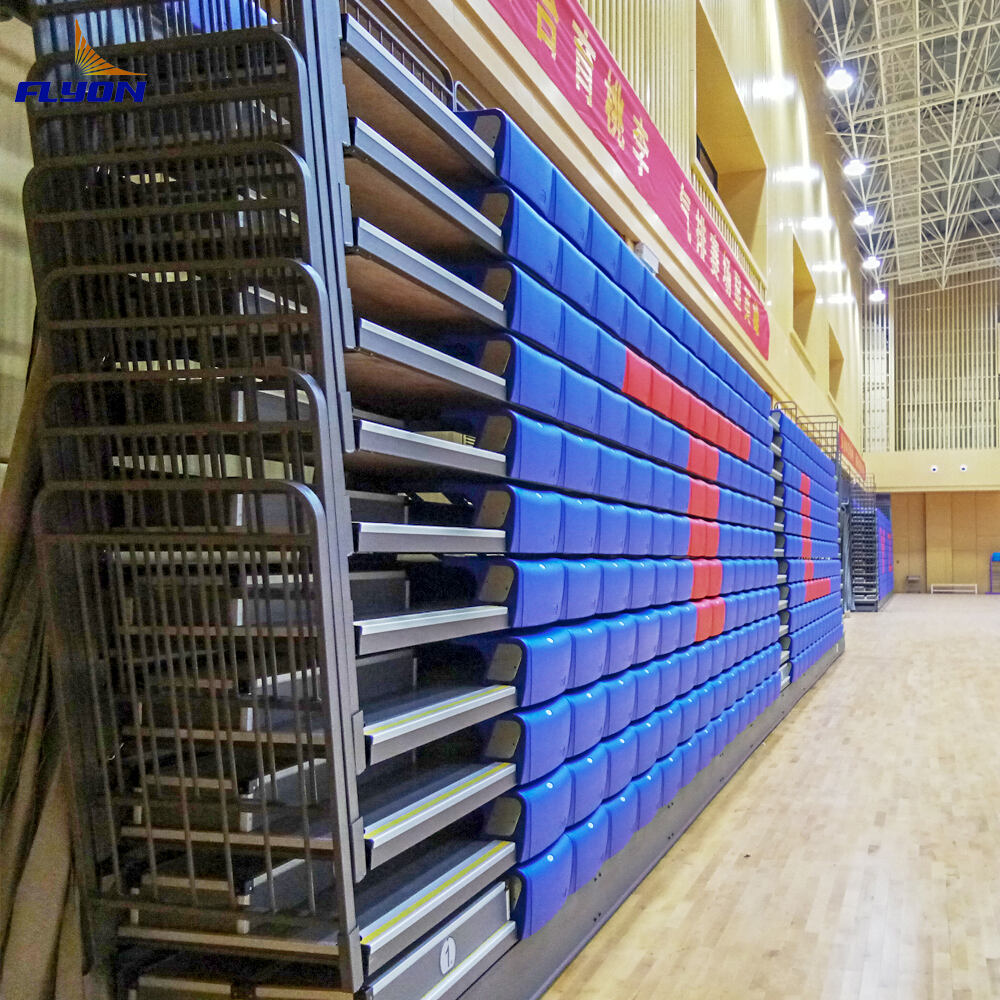How Retractable Bleachers Work: Core Mechanics and Key Components
What Are Retractable Bleachers?
Retractable bleachers basically save space by folding up either vertically or horizontally whenever nobody needs them, freeing up valuable floor area in event spaces. Most models have these interlocking platforms that slide along metal tracks, which helps spread out the weight so everything stays stable during use. They work great in places like school gyms, community theaters, and those big conference halls that host different events throughout the week. The best part? No need to commit to permanent seating arrangements when flexibility matters most for changing event needs.
Mechanical Overview of Telescopic Bleacher Seating Systems
Modern telescopic systems use one of two operational designs:
- Manual systems require 2–4 staff members to deploy via hand cranks or lever mechanisms—common in smaller venues with infrequent reconfigurations.
- Motorized systems enable single-operator control through wall-mounted switches or remote interfaces, ideal for high-traffic facilities.
Both rely on precision-engineered components like cantilevered frames and sealed bearing rollers to ensure smooth extension and retraction. A 2023 survey of community centers found automated systems reduced setup time by 63% compared to manual alternatives.
| Operational Feature | Manual Systems | Motorized Systems |
|---|---|---|
| Setup Time (500-seat capacity) | 45–60 minutes | 8–12 minutes |
| Annual Maintenance Cost | $1,200–$1,800 | $2,500–$3,200 |
| Ideal Venue Size | < 10 events/month | 20 events/month |
Essential Components of Compact Retractable Bleacher Structures
Four elements define reliable retractable bleacher performance:
- Telescoping tracks: Powder-coated steel rails guide platform movement while resisting corrosion
- Load-bearing rollers: Nylon or polyurethane wheels rated for 1,200–1,500 lbs per linear foot
- Interlock safeguards: Automatic bolt locks engage when platforms reach full extension
- Cantilever supports: Engineered steel arms eliminate vertical support columns for unobstructed floor space
Leading manufacturers subject these components to 100,000+ cycle stress tests, ensuring 15–20 years of daily operation in demanding environments.
Space Efficiency and Flexibility Benefits for Small and Multi-Use Venues
Maximizing Limited Space with Retractable Bleacher Seating
Retractable bleachers eliminate wasted floor space through vertical stacking and horizontal telescoping. Unlike fixed seating, they collapse into a footprint up to 85% smaller when stored, freeing space for exhibitions, sports practices, or emergency access. Quick-release mechanisms allow deployment or retraction in under 10 minutes using basic tools.
Designing for Multi-Purpose Use: Seamless Transitions Between Events
Multi-use venues benefit from three adaptable design features:
- Modular tiers that adjust from 5 to 15 rows based on attendance needs
- Rotating guardrails that reconfigure for ADA compliance or crowd control
- Interchangeable decking (carpeted, hardwood, or athletic surfaces)
This flexibility enabled a 400-seat convention center in Indianapolis to host 14% more annual events by pivoting between trade shows, concerts, and youth sports tournaments.
Solving the High-Capacity, Minimal-Footprint Challenge in Small Venues
Retractable bleachers resolve spatial conflicts in venues under 10,000 sq ft through:
- Vertical expansion: 3-tier systems increase seating density by 40% vs single-level layouts
- Perimeter-mounted tracks that preserve central floor space
- Partial deployment capabilities for hosting simultaneous small events
A 2023 industry study showed venues using telescopic seating hosted 34% more spectators annually than comparable facilities with permanent bleachers.
Design Strategies for Optimizing Space with Telescopic Bleacher Layouts
Key Principles in Compact Retractable Bleacher Design
Case Study: Achieving Space Savings in a 500-Seat Community Center
In 2022, a community center somewhere in the Midwest swapped out their old fixed bleachers for these new telescoping ones, which cut down on space they took up by almost half - around 42%. What makes these seats so clever is their two part design that lets them only extend partially when hosting smaller gatherings, saving the place about eighteen thousand dollars each year on electricity bills. After putting them in, they did some follow up checks and found that nearly everyone loved them, clocking in at 93% approval rate among users. The staff noticed something interesting too: since it takes much less time to rearrange everything now, they've seen their event calendar fill up way more often than before, probably around 40% more bookings overall.
Urban Trends: Growing Demand for Temporary and Flexible Event Seating
City venues are increasingly turning to telescopic systems these days since they need to accommodate anywhere from five to seven different events each week. Think esports competitions one day and temporary markets the next. The demand for retractable seating has really taken off in smaller urban areas with populations below half a million people. According to data from the Urban Events Council released last year, this market saw a massive 68% increase between 2020 and 2023. Most new installations across municipalities now feature hybrid designs that mix portable components with fixed anchor points. These setups make up around three quarters of all recent projects because planners want spaces that can change quickly but still stand up to regular use without falling apart after just a few months.
Portable vs. Permanent Retractable Bleacher Systems: Choosing the Right Fit
Comparing Portable and Permanent Telescopic Bleacher Systems
Retractable bleachers on wheels with no tools needed for setup make it easy to rearrange seating when venues need to switch between multiple events throughout the week. The permanent alternatives need concrete foundations and must be installed by professionals, but they can hold about 40 percent more weight per square foot (around 100 PSF total) which is why schools often go this route for their gyms where crowds get really dense. According to a survey from the Venue Management Institute last year, these portable options typically come out around $30 to $50 cheaper initially compared to fixed installations. However things change over time because maintenance tends to eat into savings after about five years of use.
When to Choose Portable Solutions for Small or Evolving Venues
Modular telescopic seating systems excel in spaces under 10,000 sq. ft. where seasonal demands vary—portable units helped 78% of community centers maintain COVID-19 social distancing protocols while retaining revenue streams (National Recreation Association, 2022). Prioritize portable designs when:
- Venues host alternating events less than 72 hours apart (e.g., basketball games → trade shows)
- Future expansion plans might relocate seating areas
- Budgets prohibit structural modifications like reinforced floors
Space-efficient bleachers with vertical storage reduce footprint requirements by 60% compared to fixed seating, making them ideal for urban multipurpose facilities.
Selecting the Ideal Retractable Bleacher System for Your Venue’s Needs
Matching System Capacity to Venue Size and Usage Patterns
Choosing the right retractable bleachers starts by looking at how much space is available versus how many people will actually show up. Smaller facilities below 10,000 square feet generally go for telescopic models with around 3 to 5 tiers that can seat between 150 and 300 folks. Larger multi-purpose arenas tend to want something more flexible with extra modules they can attach as needed. Take a school gymnasium for instance, one that runs basketball games every week plus occasional exhibitions. These places really need bleachers with deeper seats (about 22 inches works well) so spectators aren't cramped during sports events, plus ones that slide back quickly when they need to free up the court space again in just 15 minutes flat. According to industry reports, facilities that match their seating capacity to actual busy times instead of buying for those rare big crowds end up wasting 34% less space overall.
Evaluating Safety Standards, Installation Requirements, and Long-Term Maintenance
All retractable bleachers must meet ASTM F2157 standards for load-bearing capacity (minimum 100 lbs/sq. ft.) and guardrail stability. Key considerations include:
- Floor anchoring: Concrete subfloors require 1/2" diameter expansion bolts spaced ≤ 4 ft. apart
- Obstruction clearance: 36" retraction paths free from electrical panels or structural columns
- Maintenance cycles: Annual lubrication of roller bearings and biweekly debris removal from track systems
Leading manufacturers now embed IoT sensors in premium models to alert facilities about component wear 30–60 days before failures occur, cutting emergency repair costs by 58%.
Balancing Flexibility Demands with Budget Constraints in B2B Procurement
Automated retractable bleachers can cut down on labor expenses by around 80% when compared to traditional manual systems, but let's face it, those price tags of $75 to $120 per square foot really put a strain on smaller budgets, especially anything below $200k. Most facilities end up going with a mix of both technologies instead. They'll install the automated stuff where people actually move around a lot, like VIP sections that need to be retracted about ten times each month, while sticking with manual systems in less important spots. A lot of mid-sized places find success with gradual expansions too. Adding roughly 100 seats every year for three years helps them keep money flowing properly without losing out on future growth opportunities. And here's something worth knowing from industry insiders: getting those long term service agreements right at purchase time makes a big difference. Venues that lock in 10 year contracts usually save between 22% and 40% overall because they get all sorts of maintenance work and replacement parts at discounted rates.
FAQ
What are the main advantages of retractable bleachers?
Retractable bleachers offer space efficiency and flexibility in venues, allowing them to adapt to varying event needs without committing to permanent seating arrangements.
How do manual and motorized telescopic bleacher systems differ?
Manual systems require multiple staff for deployment, making them better suited for smaller venues. Motorized systems allow single-operator control, ideal for high-traffic facilities, and they significantly reduce setup time.
What components ensure the reliability of retractable bleachers?
Key components include telescoping tracks, load-bearing rollers, interlock safeguards, and cantilever supports, all of which are subjected to rigorous stress tests.
Why are retractable bleachers favored in urban venues?
Urban venues prefer retractable bleachers for their ability to host multiple events each week with varying seating arrangements, catering to diverse needs such as esports competitions and temporary markets.
How do portable and permanent bleacher systems compare?
Portable systems offer easy setup and flexibility for changing events, while permanent systems are more durable and suitable for high-capacity needs, often found in school gymnasiums.
What should venues consider when selecting retractable seating?
Venues should consider their size, usage patterns, safety standards, installation requirements, and long-term maintenance needs when selecting the ideal retractable bleacher system.
Table of Contents
- How Retractable Bleachers Work: Core Mechanics and Key Components
- Space Efficiency and Flexibility Benefits for Small and Multi-Use Venues
- Design Strategies for Optimizing Space with Telescopic Bleacher Layouts
- Portable vs. Permanent Retractable Bleacher Systems: Choosing the Right Fit
- Selecting the Ideal Retractable Bleacher System for Your Venue’s Needs
-
FAQ
- What are the main advantages of retractable bleachers?
- How do manual and motorized telescopic bleacher systems differ?
- What components ensure the reliability of retractable bleachers?
- Why are retractable bleachers favored in urban venues?
- How do portable and permanent bleacher systems compare?
- What should venues consider when selecting retractable seating?
 EN
EN
 AR
AR
 FR
FR
 PT
PT
 RU
RU
 ES
ES
 BG
BG
 HR
HR
 CS
CS
 DA
DA
 NL
NL
 FI
FI
 DE
DE
 EL
EL
 HI
HI
 IT
IT
 JA
JA
 KO
KO
 NO
NO
 PL
PL
 RO
RO
 SV
SV
 CA
CA
 TL
TL
 ID
ID
 SR
SR
 SK
SK
 UK
UK
 VI
VI
 HU
HU
 TH
TH
 TR
TR
 MS
MS
 AZ
AZ
 KA
KA
 BN
BN
 LO
LO
 MN
MN
 MY
MY
 UZ
UZ


